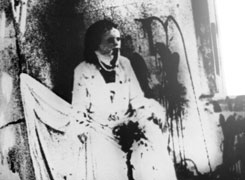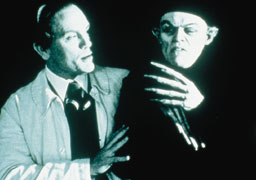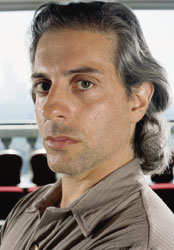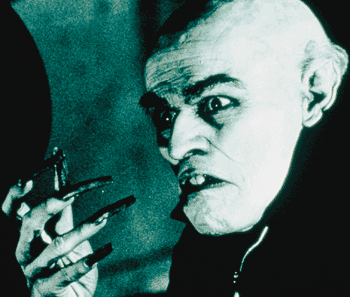SUNRISE, SUNSET
In 1921 German Expressionist director F. W. Murnau made a Dracula- inspired vampire film entitled Nosferatu: A Symphony of Horror, with a mesmerizing actor named Max Schreck in the title role. It remains one of the creepiest horror films of all time. Shadow of the Vampire – the harrowingly funny and strangely moving new film by director E. Elias Merhige – reimagines Murnau, Schreck and the making of Nosferatu, with the help of Nietzschean philosophy, Stanislavski’s acting techniques and several pints of human blood. Chuck Stephens talks with Merhige about the mad science of silent filmmaking, director-Gods and method-Monsters, and how, with the help of John Malkovich and Willem Dafoe, he went about re-staking Nosferatu’s claim.
A decade ago, E. Elias Merhige a S.U.N.Y. graduate then in his early 20s, made a film called Begotten – one of the strangest American independent movies of the last 20 years. Scratched, mottled and sometimes altogether obliterated, Begotten’s images of dying gods and umbilical martyrs – all created on an optical printer that Merhige built himself – seemed to suggest something like a new creation-myth of the world or a lost artifact from the silent cinema that had been found decaying at the bottom of the sea. Susan Sontag, with characteristic hyperbole, called it "one of the 10 most important films ever made," and Time magazine – which included Begotten in its annual Ten Best list – seemed to agree. But since that day Merhige (pronounced marriage, like the occasion he recently enjoyed), has been something of an invisible man, always working, if only on the distant edges of the Hollywood fray. When singer Marilyn Manson, a big Begotten fan, asked him to direct a video for his single "Anti-Christ Superstar," the director agreed. The video won a Golden Gate award at the San Francisco International Film Festival, but MTV, Merhige disappointedly recalls, "pulled it off the air after only two days." Now he’s set his sights on a different sort of ghoul. Shot on location in Luxembourg and stuffed with period detail, Shadow of the Vampire reimagines the production of Nosferatu (which broke with Expressionist convention in its own meticulous location-work) as a place where fiction and documentary, not to mention acting and being, were recklessly, artfully created anew. In fact, the film wonders whether Schreck wasn’t something quite supernatural in his own right – and hardly an "actor" at all.
As the s/m-and-opiate-dabbling Murnau, John Malkovich brings a spittle-flecked passion to the (fictionalized) role of the man who went on to direct The Last Laugh and Sunrise and died in a car wreck on the California coast in 1932 just days before his final film, Tabu (co-directed with Robert Flaherty), had its Hollywood debut. But it’s Willem Dafoe’s heartbreaking performance as the ultimately unknowable Schreck that steals the show. Pink and withered as a shaved bat, his heavily soiled eight-inch fingernails clittering together like restless razor clams, Dafoe as a vampire-playing an actor playing a vampire is as sympathetic as he is shocking, and as indelible as Schreck himself.
Although the marketing mumbo-jumbo behind Shadow of the Vampire would have you believe that Max Schreck (1879—1936) was "little known" and "an actor of no distinction," in fact he made at least 15 films (most of them probably lost) and worked twice with Murnau; both of them had been associated with theatrical impresario Max Reinhardt’s Berlin Staatstheater. Was Schreck (German for "fear") a stage name? No one seems to know. Yet he remains one of the most influential German actors of all time, and his performance as Nosferatu’s Count Orlock made a lasting impact on neo-expressionist madman-actors Klaus Kinski (who played Schreck in Werner Herzog’s 1979 Nosferatu remake) and cockroach-gobbler Nicolas Cage, Shadow of the Vampire’s co-producer.
A metaphysical study of the on-set power dynamics between an all-controlling director and an altogether uncontrollable star, Shadow of the Vampire is a portrait of the ways in which, in the madness of the movie-making moment, it’s never quite clear who’s running the show: the mad scientist or the bloodsucking ghoul. As Schreck at one point hungrily opines, "I don’t think we need the writer anymore," and Murnau – for that instant the most typical of directors – very nearly concurs. And yet Elias Merhige, like the shadow of F. W. Murnau, is far from typical.
 |  |
| Left: from E. Elias Merhige's Begotten; Right: John Malkovich as
F.W. Murnau and Willem Dafoe as Nosferatu in Shadow of the Vampire. | |
Filmmaker: First things first: who is Fred Schreck?
E. Elias Merhige: Do you mean Max Schreck?
Filmmaker: No, Fred Schreck – the name that appears in the end credits of Begotten.
Merhige: You have done your homework. Fred Schreck was this very intense, older man with a thick German accent who had come over right after World War 11 and worked in the darkroom at Kin-O-Lux Labs up on 48th Street in Manhattan. I had gone to Kin-O-Lux to ask if they would develop some film tests I had shot for Begotten at a slightly different temperature than they normally do; no lab in the world would ordinarily even consider it. But because this lab was small enough and because Fred took a liking to me, to my experimentalist way of doing things, he invited me into the lab. The smell was intense, like sulfuric acid, and you couldn’t breath in there because it was so poorly ventilated. It was like a scene out of Eraserhead: metal tanks, encrusted and calcified. Fred handed me a pair of rubber gloves and taught me how to hand-develop film. Without Fred, I would never have been able to achieve the look of Begotten.
Filmmaker: Did you ever ask him if he was related [to Max]?
Merhige: At that time I was aware of Nosferatu, but I’d never spent any time wondering about the actor who played him. I always figured that Schreck was just a stage name.
Filmmaker: How did Begotten come about?
 |
| Director E. Elias Merhige. Photo by Richard Kern. |
Filmmaker: What hopes did you have of getting it seen?
Merhige: Before Susan Sontag saw it, I had people telling me I’d be lucky if I could ever show the film for free somewhere. Peter Scarlet and Tom Luddy had decided to include it in the San Francisco Film Festival, though I got the sense that they weren’t too sure about it themselves. So they asked Susan if she would look at it. She loved it and asked me to project it in her living room for a group of her friends.
Filmmaker: At that time, did you plan to continue making experimental films, or did you plan to head to Hollywood?
Merhige: To me, all filmmaking is experimental. It’s always about taking ideas out of thin air and making something solid with them. I never said to myself, ‘Oh, I’m going to be an independent filmmaker,’ or a studio filmmaker, or thought about whether I was going to be working in Hollywood or in Europe.
Filmmaker: Shadow of the Vampire feels in certain ways more European than American. I know you’re an admirer of Werner Herzog. Was his version of Nosferatu an influence in any way?
Merhige: If you look at Herzog’s Nosferatu, which I respect very much, what you see is an homage to the master, which is what Murnau is for Herzog. Shadow of the Vampire is much more irreverent, and more about invigorating an enthusiasm for the period, and about trying to invoke the past within the present. If those guys were working today, what would their color palette be? How would they work with sound? In the film, I tried to suggest that wherever I could. When the images are in color, for example, we’re in digital surround-sound Dolby stereo. But when we move into black and white, I asked my sound editor to transfer all the sound to wax cylinders, so that everything goes down to mono and sounds a bit ancient. You’re actually doing time travel with your ears.
Filmmaker: How else did you approach the project in terms of period authenticity? What about, for example, the vintage cameras in the film?
Merhige: The camera we used in the film – the camera in the studio in the opening scene – is actually Murnau’s own camera. We got it through a motion picture museum in Munich; the camera itself is in the private collection of the man who runs the museum. He actually came and oversaw our use of it. Using Murnau’s camera was like a magical device for bringing the past forward, and it corresponded with my desire to use actual scenes from Nosferatu, to mix Murnau’s original shots in among our re-creations. Some of the on-location cameras were replications that we had built, but the camera you see at the end, when you see the internals of the camera – that’s Murnau’s own camera.
Filmmaker: Yikes! Using Murnau’s own camera – it’s a bit like opening a coffin and finding a corpse still living inside, still whirring away. The movie’s credit sequence is quite exquisite, a kind of resurrection of a certain time. The images seem somehow both Art Deco and a representation of the moment when Cubism began to chop Art Deco to bits. How were they designed?
Merhige: I wanted a really grand credit sequence, like something from an old studio movie, so that by the time the film begins, you’ve already been brought, nostalgically, into the past. The images themselves came mainly from a book of speculative rituals of the Knights Templar of the 13th century, who were the crusaders protecting the holy sepulchre of Christ in Jerusalem. I fashioned them into a narrative and wanted them to look like illuminated drawings; there’s also some hand-developed film that we layered over them to give them a certain kind of patina. There are little handmade details throughout the film.
Filmmaker: Those dissolves, through portal after portal, also suggest an kind of entry into a grand movie palace from the past, and the way one might spend time studying the ornate decorations on the walls and ceiling before the movie begins.
Merhige: Exactly, the palace of the imagination . . .
Filmmaker: . . . or the movie theater as 20th century variation on Plato’s cave?
Merhige: That’s right. There was even a scene that got cut, between Cary Elwes, who plays Murnau’s second camera man, and Willem Dafoe, where the cameraman asks Schreck: "Have you read Plato?" And Schreck says, "Read him? I knew him!"
Filmmaker: He might have said, "I ate him."
Merhige: [laughing] He might have.
Filmmaker: What intrigued you about Murnau as a historical figure?
Merhige: Murnau came up through the period after World War I, in a decimated Europe, and he wanted to create an effigy of the pestilence, the plague that had destroyed Germany and brought about a loss of faith and dignity and identity. Here was this wildly idealistic artist, F. W. Murnau, going off into the hills to wake up this monster. It was as if the old pagan myths that Wagner and Schopenhauer and Nietzsche had been working with were all of a sudden distilled and brought to the surface by Murnau.
Filmmaker: I understand that Steven Katz’s script already contained the idea that Schreck’s vampirism might somehow have been connected with, or disguised as, Stanislavski’s acting techniques. What sorts of things did you bring in that weren’t in the script?
Merhige: When I first read the script, I loved what I read, but much of its original structure seemed to aspire mainly to the level of a very highbrow vampire movie. It’s still a vampire movie, but I saw it as a way to look backwards at the history of cinema, to try to resurrect the power of cinema when it was still a fringe artform. In Murnau’s time the cinema was looked at as form of sorcery, a kind of black magic that many people didn’t want to see. That’s part of the reason why Bram Stoker’s estate didn’t want to see Dracula produced as a movie, because it was thought to be much more dignified to present it as a stage play in London. We all know that part of the theater experience is that it’s like writing on water – once it’s over, it’s gone. Films, though, take on new life with every new generation that watches them. Yet the camera drains its subjects of flesh and blood and reduces them to shadows that only exist as a living entities when the human eye gazes upon them. It’s an idea that runs throughout the film, even to the extent that there’s a sort of psychological anxiety that takes over when parts of the film go into black and white, and a kind of relief when they go back into color. Those sorts of aesthetic and stylistic choices were things I saw the first time I read the script, but they were still latent, and needed to be brought to the fore.
Filmmaker: There’s a line of thought running through Shadow of the Vampire about the god-like nature of the director.
Merhige: At about the same period that Murnau was making Nosferatu, you also have Wittgenstein coming up with a philosophy of grammar, and arguing that if something can’t be grammatically realized, it doesn’t exist, or that it’s nonsense or gibberish. And in Shadow, you have these filmmakers saying that what they are making is the world, that "This is the frame, and beyond the frame, nothing exists." In the first scene in the film, with Murnau and his crew elevated on the studio rostrum in their lab coats and goggles, they look like scientists – they look like gods. I told the cast before shooting began that day, that just 40 years before that moment, Nietzsche was talking about the death of God and the death of spiritualism in western European culture, and now here come you guys in the 20th century: "You’re the new gods. You are the worldmakers." They were the ones constructing these dreams of the future, the worlds that future generations would discover and inhabit.
Filmmaker: The poetic passages at the end of the film are extraordinary; the lines where Murnau is damning Schreck as "the death of centuries. Moonchaser. Blasphemer. Monkey. Vase of pre-history . . . finally to Earth, finally born . . ."
Merhige: Most of those lines came about from going back and forth with John Malkovich, from the two of us writing and rewriting things, scribbling notes on restaurant napkins, trying to get the end sequence in order. If you look at early Gnostic, Assyrian and Greek mythologies, those are all names for the sun, and Malkovich’s son had called the sun "Moonchaser," too. So John even brought in private aspects of his own fatherhood to incorporate alongside some of the esoteric crap I kept throwing at him. And he really inhabited the character of this Murnau, really understood this promethean force in cinema who was out to change the world through science and art.
In the film, this fictionalized Murnau realizes that flesh and blood rots, that memory rots, but that cinema is forever. It doesn’t matter to Murnau if he’s a rotten bastard or a murderer. Who gives a shit about life? He was only concentrating on the fact that, 100 years from then, all that would be left was his film. That’s why I felt that the end of the story needed to go into a fever – Murnau’s fever. It’s as if he’s so moved by penetrating the world through his filmmaking that he’s retreated into the reptilian core of his own brain. Art in general, at the beginning of the 20th century, was so intoxicating and filled with madness, and yet there was so much invention taking place at the same time. Invention was married to madness, and cinema grew like a tumor, or an added organ, onto the side of the 20th century’s brain.
Filmmaker: Here we’ve jumped from the beginning of the film to the end, but in a sense, that’s the same trajectory that both Shadow and Begotten describe. They’re both about this move – almost without a middle – from beginnings, or birth, or what Murnau at the end of the first scene calls "nice pussy," to the end, to death, to what in that same scene he describes as what’s "at the bottom of the flower box": worms in the dirt, life thriving on death.
Merhige: Exactly. It’s the idea that somewhere between those two points there is some kind of transcendent experience that allows you, almost like the Janus figure, to see in through both doorways. Death’s door and "nice pussy," and the way that the two actually become the same door. It’s also connected to the painting of the sun in Schreck’s cave, which comes from a 17th-century alchemical text, and to the Gnostic sense that there is this "invisible" sun that animates everything, that penetrates both the night and the day.
Filmmaker: In a way, speaking of polarities – and perhaps this is a testament to Dafoe’s performance – Schreck is the character who is most alive in the film, even though he’s (un)dead.
Merhige: For me, Schreck is a romantic, sorrowful figure. He was once this great nobleman, a knight who has now been reduced to this rat-like fiend. He’s experienced the entire spectrum of what it is to be human, and it was important that we sympathize with him for that reason, even though we know he’s dangerous and incredibly disturbing to look at. There’s this sense of him as existing at the bottom of existence and trying to crawl back to what it is to be human, to what it is to love. And that’s expressed through the technology of the motion picture projector, in the scene where Schreck is projecting an image of the clouds and the sun. I wanted to show this precious beauty of the clouds and sun, and that as the shadow of Nosferatu’s fingers tries to grasp that beauty, he’s trying to return to what it means to be human. There’s even a moment in the film when the writer asks Schreck, "What is it you find most desirable and yet most unattainble? What do you long for?" And Schreck says, "The light of the sun."
Filmmaker: The film is linked to the sun – and to Murnau’s later Sunrise, not to mention the intense German-director bygone- Hollywood aspects of Sunset Boulevard – in the sense that making the film is what finally kills him.
Merhige: Yes, there’s definitely a sense of film as destroyer, and of both the motion picture camera and the image as kind of Gorgon or Medusa that kills those who look at it or those who are looked at by it. But there’s also the idea – when the film goes from color to black and white – of the motion picture camera as vampire. That this black box – an artifact of the Industrial Revolution that changed the world as surely as the steam engine changed the American West – is a kind of mechanical eye that fixes its gaze on a subject, and takes its blood and flesh away. It reduces its subjects to shadows, and those shadows then become eternal phantoms, wandering the earth forever.
Filmmaker: Where do you go from here?
Merhige: For years I’ve been doing research on the Knights Templar. What fascinates me is the way that so much of European history was carried, genealogically, through the Templars, and then subsequently got lost. I’m interested in the lost knowledge of Renaissance Europe, the knowledge that the neo-Platonists of the time tried so desperately to retrieve and preserve. But I haven’t found the right story to tell with the material quite yet.
Filmmaker: Ambitious stuff. Is there anything you’ve learned through filmmaking that might stand as some kind of advice or instruction for aspiring filmmakers?
Merhige: One thing I’ve learned over the last nine years is that being a film director is not something anyone deserves to be doing. It’s a privilege. Film directors are really [modern-day] bards and poets, and as a director, you are put in charge of what society sees at the periphery of its vision. At the periphery of society’s vision, society sees these ghosts. But when they try to turn and fix their eyes upon them, those ghosts disappear. What the filmmaker does is take those ghosts and turn them into dramatic images that can be shared and explored. At it’s best, filmmaking becomes this homeopathic consciousness, and a truly expanding experience.
VOD CALENDAR


 See the VOD Calendar →
See the VOD Calendar →



